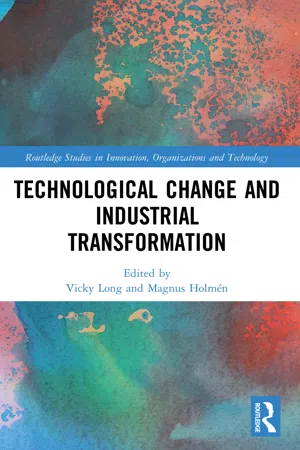
Technological Change and Industrial Transformation
- 272 pages
- English
- ePUB (mobile friendly)
- Available on iOS & Android
Technological Change and Industrial Transformation
About this book
Industrial transformation is a research and teaching field with a focus on the phenomenon and mechanisms of industrial development and renewal. It concerns changes in economic activities caused by innovation, competition and collaboration, and has a rich heritage of evolutionary economics, institutional economics, industrial dynamics, technology history and innovation studies. It borrows concepts and models from the social sciences (sociology, history, political sciences, business/management, economics, behavioural sciences) and also from technology and engineering studies.
In this book, the authors present the key theories, frameworks and concepts of industrial transformation and use empirical cases to describe and explain the causes, processes and outcomes of transformation in the context of digitalization and sustainability. They stress that industrial transformation consists both of Darwinian "survival of the fittest" selection, and of intentional pursuits of innovation, and of industrial capabilities creation. The work argues that managing the global trends of transformation is not only about new technology and innovation: existing institutional settings and dynamic interactions between technological change, organizational adaptation and economic activities also have a profound impact on future trajectories.
The areas under investigation are of great relevance for strategic management decisions and industrial and technology policies, and understanding the mechanisms underlying transformation and sustainable growth.
Frequently asked questions
- Essential is ideal for learners and professionals who enjoy exploring a wide range of subjects. Access the Essential Library with 800,000+ trusted titles and best-sellers across business, personal growth, and the humanities. Includes unlimited reading time and Standard Read Aloud voice.
- Complete: Perfect for advanced learners and researchers needing full, unrestricted access. Unlock 1.4M+ books across hundreds of subjects, including academic and specialized titles. The Complete Plan also includes advanced features like Premium Read Aloud and Research Assistant.
Please note we cannot support devices running on iOS 13 and Android 7 or earlier. Learn more about using the app.
Information
1
WHY THIS BOOK?
Introduction
The new stylized facts
Digitalization
- Technological developments in fields like big data, cloud computing, the IoT, ML, AI and Industry 4.0.
- The rapid growth of artefacts, applications, services, processes, standards (protocols) and platforms produced by industry actors, ranging from basic connectivity (switches and grids) to highly interactive and big data analysis-based content services (Facebook, Uber). Some products (smart grid) are relevant to specific industries and customer segments, but increasingly more products and offerings (augmented reality, Swish/Alipay as a mobile payment app) have a platform function, a generic enabling function, which is instrumental to the transformations of other industry sectors and the whole of society.
- Observed laws and regularities such as Moore’s law3 and the “second half of the chess board”,4 related to the rate and the direction of technological development.
- Mechanisms such as increasing returns, network effect and externalities. Increasing returns due to the scale and scope of development, production and adoption are frequently observed (e.g., in operating systems); network effects arise on the demand side (e.g. in Facebook, World of Warcraft), creating a bandwagon effect. It may be assumed that when some of the mechanisms are in operation, there is an effective tendency towards monopoly (as indicated by Google or Amazon, for example). Such an outcome, however, is not predetermined because these mechanisms may also be counteracted by new technologies, policies or competitive forces. Blockchain, for example, supports peer-based collaboration and a decentralized governance system.
Sustainability
- It causes changes in the relative prices of the factors (land, labour, capital) of production. There is a growing consensus that the widespread problems of pollution and climate change are caused by humankind’s over-utilization of finite (natural) resources. The recent labelling of our time as the Anthropocene 6 speaks of the human-influenced atmospheric, geologic, hydrologic and biospheric conditions, which arguably threaten to wipe out other species. This changes the factor endowments of a country in general and the conditions for industrial development and transformation in particular regions. For example, a regional drought can cause the shutdown or relocation of process industries (e.g., Coca-Cola production, paper mills). At the same time, a change in environmental conditions is itself a spur to ...
Table of contents
- Cover
- Half-Title
- Series
- Title
- Copyright
- Contents
- List of contributors
- Preface
- 1 Why this book?
- 2 What do we know about industrial transformation?
- 3 How digital platforms transform industries
- 4 Digital transformation of the home help service sector through welfare technology
- 5 Doing more by knowing less: The evolution of the division of innovative labour in software creation
- 6 Rags to riches: Digitalization and the transformation of the Icelandic film industry
- 7 What prevents machine learning from transforming industries?
- 8 “Own it” or “share it”: Transformations of regulatory and community norms in the Swedish housing market
- 9 Industrial transformation in the Anthropocene
- 10 Is the oil and natural gas industry transforming?: Evidence from the offshore Arctic
- 11 The industrial transformation of the Swedish heat pump sector
- 12 Conclusions
- Index